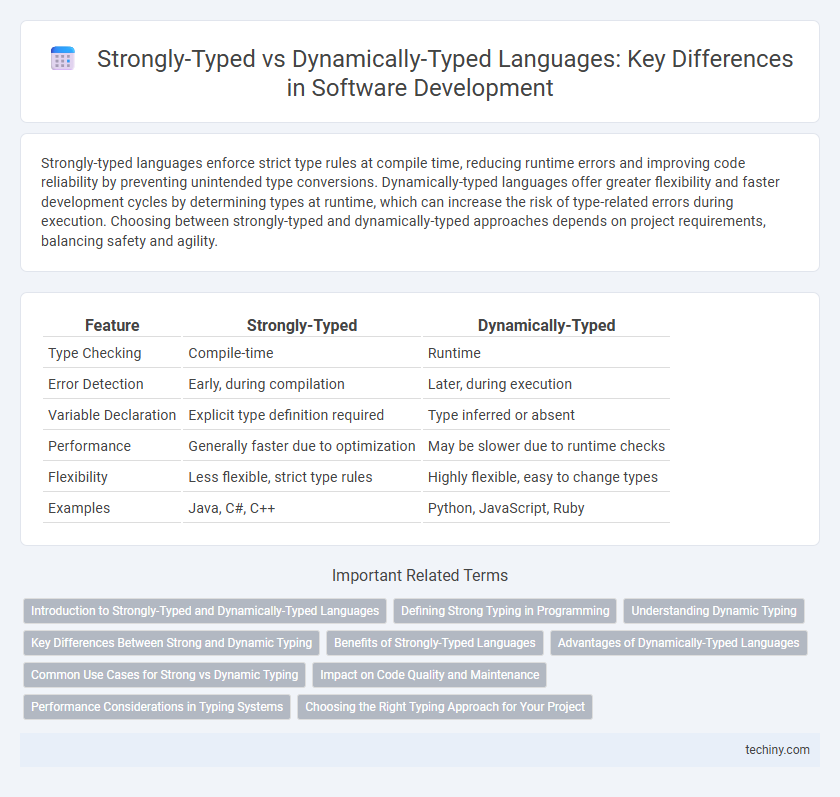Strongly-typed languages enforce strict type rules at compile time, reducing runtime errors and improving code reliability by preventing unintended type conversions. Dynamically-typed languages offer greater flexibility and faster development cycles by determining types at runtime, which can increase the risk of type-related errors during execution. Choosing between strongly-typed and dynamically-typed approaches depends on project requirements, balancing safety and agility.
Table of Comparison
| Feature | Strongly-Typed | Dynamically-Typed |
|---|---|---|
| Type Checking | Compile-time | Runtime |
| Error Detection | Early, during compilation | Later, during execution |
| Variable Declaration | Explicit type definition required | Type inferred or absent |
| Performance | Generally faster due to optimization | May be slower due to runtime checks |
| Flexibility | Less flexible, strict type rules | Highly flexible, easy to change types |
| Examples | Java, C#, C++ | Python, JavaScript, Ruby |
Introduction to Strongly-Typed and Dynamically-Typed Languages
Strongly-typed languages enforce strict type rules at compile-time, preventing type errors and enhancing code reliability through explicit type declarations. Dynamically-typed languages determine variable types at runtime, offering flexibility and faster prototyping but potentially increasing the risk of runtime type errors. Understanding the differences between these typing disciplines is crucial for selecting the appropriate programming language based on project requirements and development speed.
Defining Strong Typing in Programming
Strong typing in programming enforces explicit data types for variables, ensuring type safety by preventing implicit type conversions that could lead to runtime errors. Languages like Java and C# exemplify strongly-typed systems, requiring developers to declare variable types and allowing the compiler to catch type mismatches early. This approach enhances code reliability and maintainability by reducing bugs associated with unexpected type coercion.
Understanding Dynamic Typing
Dynamic typing allows variables to hold data of any type without explicit declaration, enabling flexible and rapid development in languages like Python and JavaScript. This approach reduces the need for upfront type specification, which can accelerate prototyping and make code easier to write but may increase runtime errors due to type mismatches. Developers must rely on extensive testing and debugging strategies to manage the potential risks associated with dynamic typing in software development.
Key Differences Between Strong and Dynamic Typing
Strongly-typed languages enforce strict type rules at compile-time, reducing runtime errors by catching type mismatches early, while dynamically-typed languages determine types at runtime, offering greater flexibility and faster prototyping. Static type checking in strongly-typed languages improves code reliability and maintainability, whereas dynamic typing enhances developer productivity by allowing variable types to change during execution. The key difference lies in error detection timing and type enforcement rigidity, influencing debugging complexity and performance optimization strategies.
Benefits of Strongly-Typed Languages
Strongly-typed languages enhance code reliability by enforcing strict type rules during compilation, reducing runtime errors and improving debugging efficiency. They facilitate better code maintainability through clear type definitions, enabling robust refactoring and static analysis tools. Strong typing also optimizes performance by allowing compilers to generate more efficient machine code tailored to specific data types.
Advantages of Dynamically-Typed Languages
Dynamically-typed languages offer greater flexibility and speed in development by allowing variables to change types at runtime, which accelerates prototyping and iterative coding. These languages reduce boilerplate code and simplify syntax, making them ideal for rapid application development and scripting tasks. Moreover, dynamic typing enhances code readability and adaptability in projects with frequently changing requirements or uncertain data structures.
Common Use Cases for Strong vs Dynamic Typing
Strongly-typed languages like Java and C# are commonly used in enterprise applications and systems requiring high reliability and maintainability due to their compile-time type checking and early error detection. Dynamically-typed languages such as Python and JavaScript are preferred in rapid prototyping, web development, and scenarios demanding flexible and iterative coding workflows. Choosing between strong and dynamic typing depends on factors like project scale, development speed, and the necessity for type safety versus coding agility.
Impact on Code Quality and Maintenance
Strongly-typed languages enforce strict type checking at compile time, reducing runtime errors and enhancing code reliability, which results in higher code quality and easier maintenance. Dynamically-typed languages offer flexibility and faster prototyping by determining types at runtime, but this can increase the risk of type-related bugs that complicate debugging and maintenance. Choosing between strongly-typed and dynamically-typed depends on project requirements, with strongly-typed favoring long-term maintainability and dynamically-typed benefiting rapid development cycles.
Performance Considerations in Typing Systems
Strongly-typed languages like C++ and Rust enforce strict type checking at compile-time, which reduces runtime errors and typically results in faster execution speeds due to optimized machine code. Dynamically-typed languages such as Python and JavaScript perform type checking at runtime, introducing overhead that can degrade performance, especially in compute-intensive applications. Choosing between these typing systems impacts performance optimization, with strongly-typed systems offering lower latency and higher efficiency in large-scale software development.
Choosing the Right Typing Approach for Your Project
Choosing the right typing approach for your software project depends on factors such as project size, performance requirements, and team expertise. Strongly-typed languages like Java or C# provide early error detection and enhanced code maintainability, which is ideal for large-scale, complex applications. Dynamically-typed languages like Python or JavaScript offer increased flexibility and faster prototyping, making them suitable for startups or projects with evolving requirements.
Strongly-Typed vs Dynamically-Typed Infographic

 techiny.com
techiny.com